Partnership and Competitive Advantage: Little Dessert Shop Report
VerifiedAdded on 2023/01/04
|9
|2668
|73
Report
AI Summary
This report provides a comprehensive analysis of business partnerships, using the 'Little Dessert Shop' as a case study to illustrate key concepts. The report begins by defining business and exploring the partnership model, specifically evaluating the advantages of a general partnership. It then applies Porter's Five Forces model to assess the competitive landscape, examining industry rivalry, supplier and buyer power, the threat of substitutes, and the threat of new entrants. The analysis focuses on how 'Little Dessert Shop' can leverage these forces to achieve a competitive advantage. Finally, the report examines the impact of macro-environmental factors, including political, economic, and environmental considerations, on the business's operations and growth. The report concludes with a summary of findings and recommendations, offering valuable insights into business strategy and market dynamics.
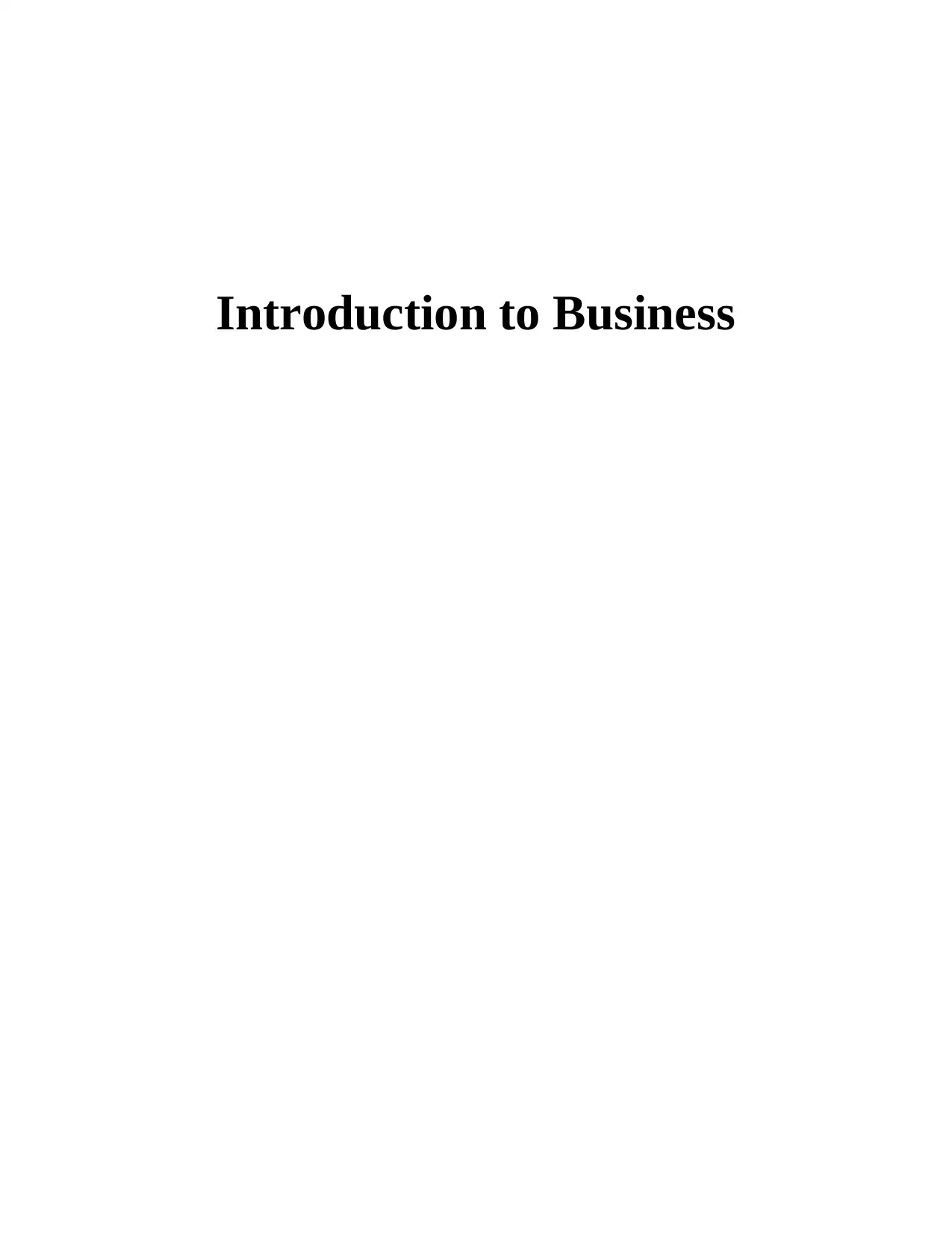
Introduction to Business
Paraphrase This Document
Need a fresh take? Get an instant paraphrase of this document with our AI Paraphraser
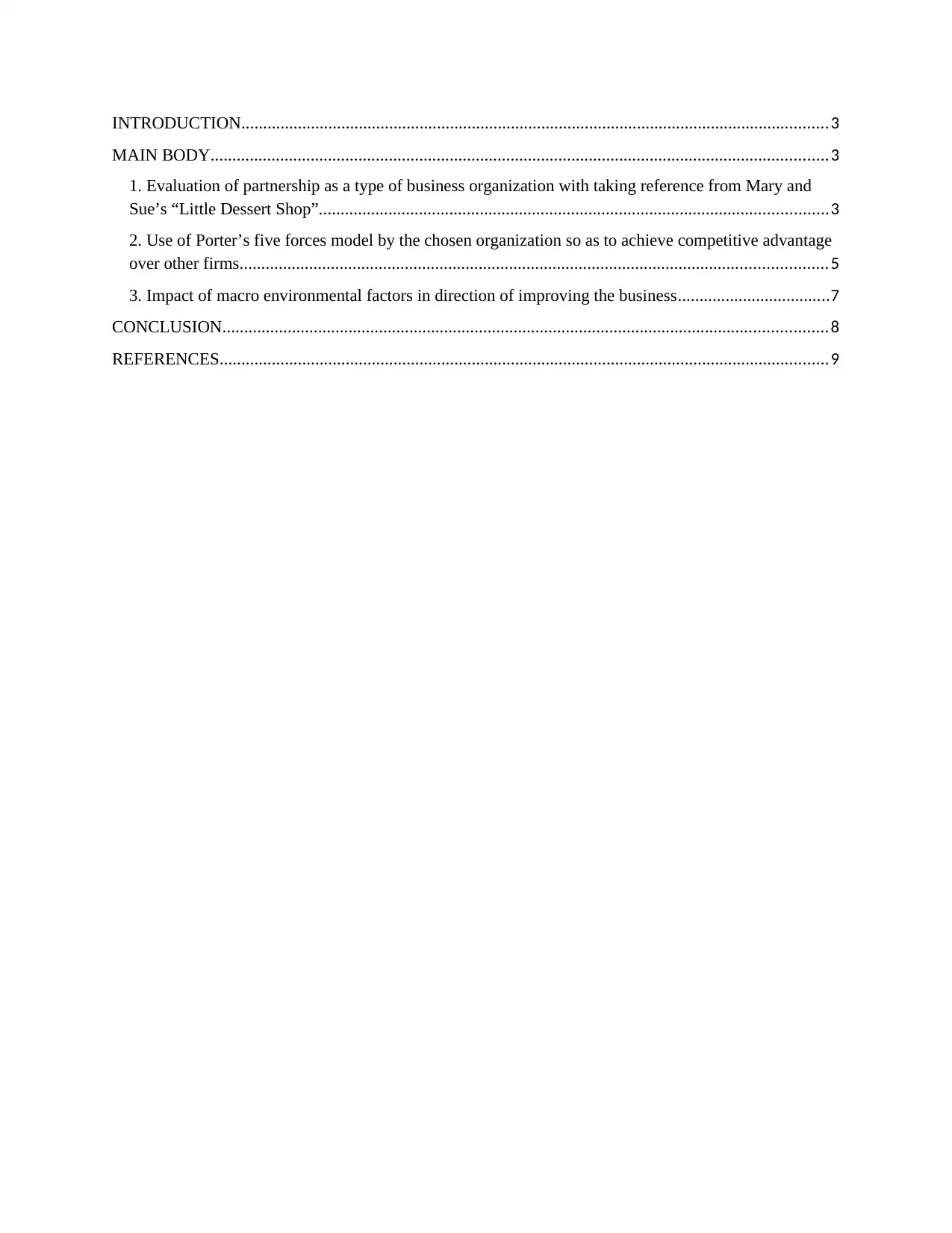
INTRODUCTION.......................................................................................................................................3
MAIN BODY..............................................................................................................................................3
1. Evaluation of partnership as a type of business organization with taking reference from Mary and
Sue’s “Little Dessert Shop”.....................................................................................................................3
2. Use of Porter’s five forces model by the chosen organization so as to achieve competitive advantage
over other firms.......................................................................................................................................5
3. Impact of macro environmental factors in direction of improving the business...................................7
CONCLUSION...........................................................................................................................................8
REFERENCES............................................................................................................................................9
MAIN BODY..............................................................................................................................................3
1. Evaluation of partnership as a type of business organization with taking reference from Mary and
Sue’s “Little Dessert Shop”.....................................................................................................................3
2. Use of Porter’s five forces model by the chosen organization so as to achieve competitive advantage
over other firms.......................................................................................................................................5
3. Impact of macro environmental factors in direction of improving the business...................................7
CONCLUSION...........................................................................................................................................8
REFERENCES............................................................................................................................................9
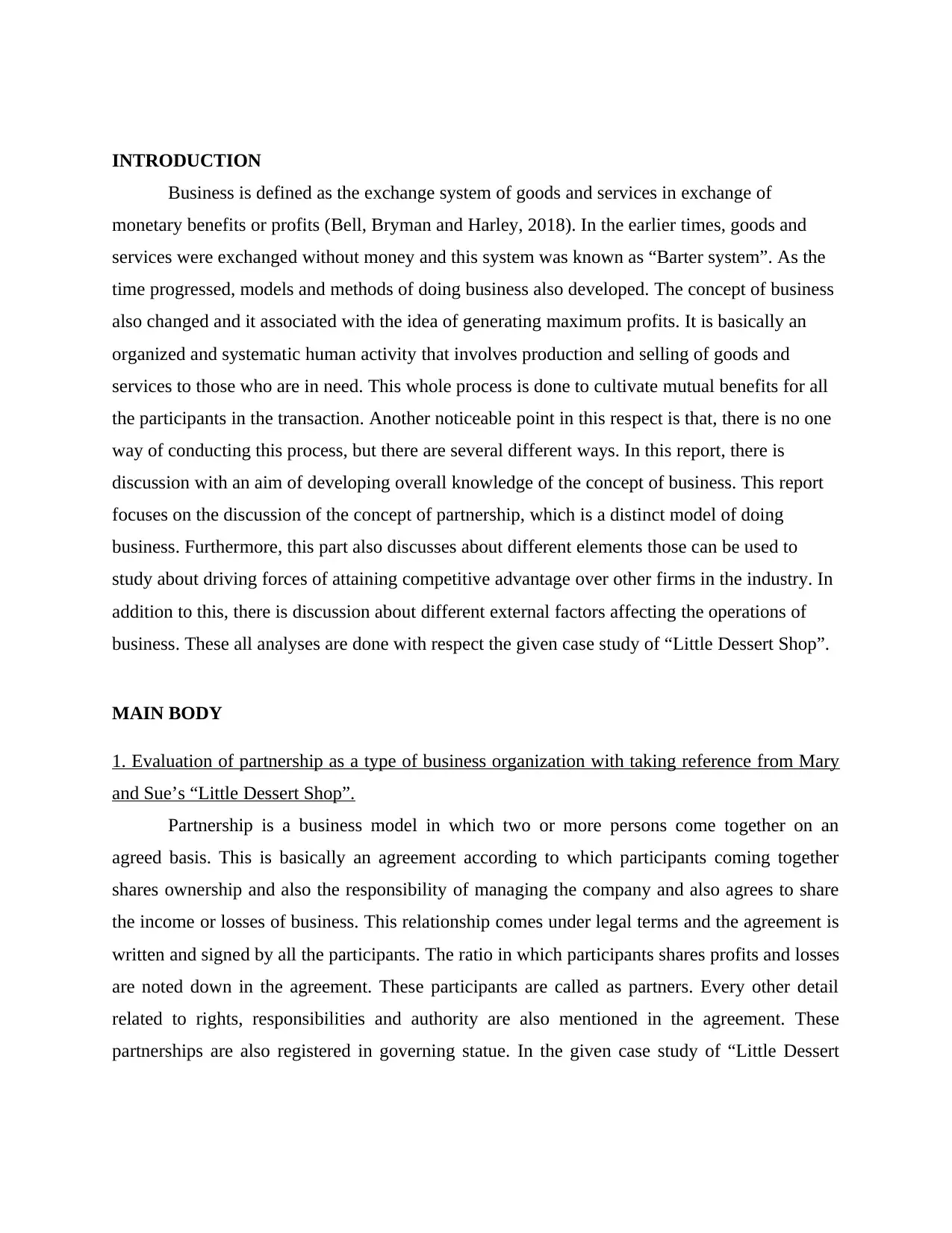
INTRODUCTION
Business is defined as the exchange system of goods and services in exchange of
monetary benefits or profits (Bell, Bryman and Harley, 2018). In the earlier times, goods and
services were exchanged without money and this system was known as “Barter system”. As the
time progressed, models and methods of doing business also developed. The concept of business
also changed and it associated with the idea of generating maximum profits. It is basically an
organized and systematic human activity that involves production and selling of goods and
services to those who are in need. This whole process is done to cultivate mutual benefits for all
the participants in the transaction. Another noticeable point in this respect is that, there is no one
way of conducting this process, but there are several different ways. In this report, there is
discussion with an aim of developing overall knowledge of the concept of business. This report
focuses on the discussion of the concept of partnership, which is a distinct model of doing
business. Furthermore, this part also discusses about different elements those can be used to
study about driving forces of attaining competitive advantage over other firms in the industry. In
addition to this, there is discussion about different external factors affecting the operations of
business. These all analyses are done with respect the given case study of “Little Dessert Shop”.
MAIN BODY
1. Evaluation of partnership as a type of business organization with taking reference from Mary
and Sue’s “Little Dessert Shop”.
Partnership is a business model in which two or more persons come together on an
agreed basis. This is basically an agreement according to which participants coming together
shares ownership and also the responsibility of managing the company and also agrees to share
the income or losses of business. This relationship comes under legal terms and the agreement is
written and signed by all the participants. The ratio in which participants shares profits and losses
are noted down in the agreement. These participants are called as partners. Every other detail
related to rights, responsibilities and authority are also mentioned in the agreement. These
partnerships are also registered in governing statue. In the given case study of “Little Dessert
Business is defined as the exchange system of goods and services in exchange of
monetary benefits or profits (Bell, Bryman and Harley, 2018). In the earlier times, goods and
services were exchanged without money and this system was known as “Barter system”. As the
time progressed, models and methods of doing business also developed. The concept of business
also changed and it associated with the idea of generating maximum profits. It is basically an
organized and systematic human activity that involves production and selling of goods and
services to those who are in need. This whole process is done to cultivate mutual benefits for all
the participants in the transaction. Another noticeable point in this respect is that, there is no one
way of conducting this process, but there are several different ways. In this report, there is
discussion with an aim of developing overall knowledge of the concept of business. This report
focuses on the discussion of the concept of partnership, which is a distinct model of doing
business. Furthermore, this part also discusses about different elements those can be used to
study about driving forces of attaining competitive advantage over other firms in the industry. In
addition to this, there is discussion about different external factors affecting the operations of
business. These all analyses are done with respect the given case study of “Little Dessert Shop”.
MAIN BODY
1. Evaluation of partnership as a type of business organization with taking reference from Mary
and Sue’s “Little Dessert Shop”.
Partnership is a business model in which two or more persons come together on an
agreed basis. This is basically an agreement according to which participants coming together
shares ownership and also the responsibility of managing the company and also agrees to share
the income or losses of business. This relationship comes under legal terms and the agreement is
written and signed by all the participants. The ratio in which participants shares profits and losses
are noted down in the agreement. These participants are called as partners. Every other detail
related to rights, responsibilities and authority are also mentioned in the agreement. These
partnerships are also registered in governing statue. In the given case study of “Little Dessert
⊘ This is a preview!⊘
Do you want full access?
Subscribe today to unlock all pages.

Trusted by 1+ million students worldwide
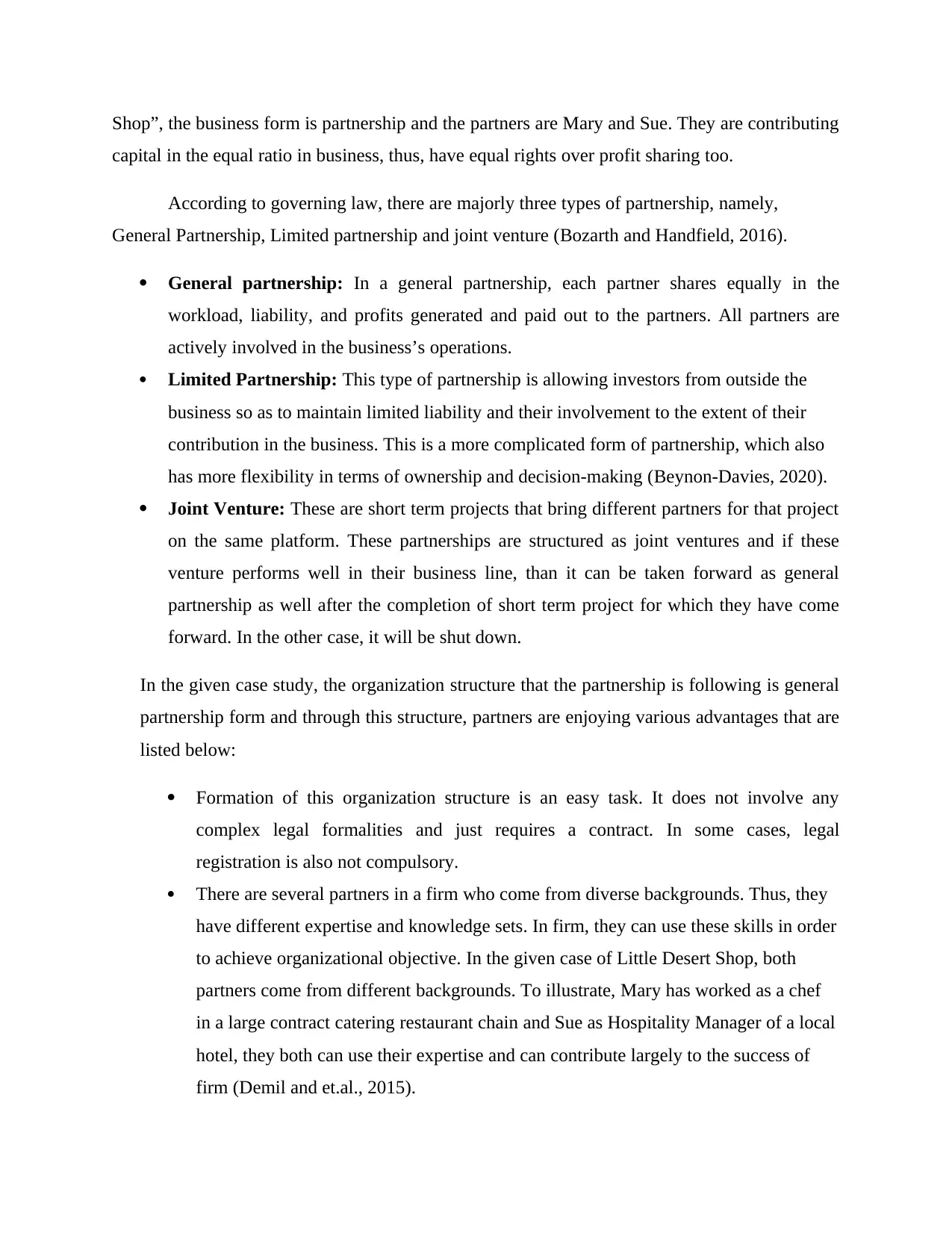
Shop”, the business form is partnership and the partners are Mary and Sue. They are contributing
capital in the equal ratio in business, thus, have equal rights over profit sharing too.
According to governing law, there are majorly three types of partnership, namely,
General Partnership, Limited partnership and joint venture (Bozarth and Handfield, 2016).
General partnership: In a general partnership, each partner shares equally in the
workload, liability, and profits generated and paid out to the partners. All partners are
actively involved in the business’s operations.
Limited Partnership: This type of partnership is allowing investors from outside the
business so as to maintain limited liability and their involvement to the extent of their
contribution in the business. This is a more complicated form of partnership, which also
has more flexibility in terms of ownership and decision-making (Beynon-Davies, 2020).
Joint Venture: These are short term projects that bring different partners for that project
on the same platform. These partnerships are structured as joint ventures and if these
venture performs well in their business line, than it can be taken forward as general
partnership as well after the completion of short term project for which they have come
forward. In the other case, it will be shut down.
In the given case study, the organization structure that the partnership is following is general
partnership form and through this structure, partners are enjoying various advantages that are
listed below:
Formation of this organization structure is an easy task. It does not involve any
complex legal formalities and just requires a contract. In some cases, legal
registration is also not compulsory.
There are several partners in a firm who come from diverse backgrounds. Thus, they
have different expertise and knowledge sets. In firm, they can use these skills in order
to achieve organizational objective. In the given case of Little Desert Shop, both
partners come from different backgrounds. To illustrate, Mary has worked as a chef
in a large contract catering restaurant chain and Sue as Hospitality Manager of a local
hotel, they both can use their expertise and can contribute largely to the success of
firm (Demil and et.al., 2015).
capital in the equal ratio in business, thus, have equal rights over profit sharing too.
According to governing law, there are majorly three types of partnership, namely,
General Partnership, Limited partnership and joint venture (Bozarth and Handfield, 2016).
General partnership: In a general partnership, each partner shares equally in the
workload, liability, and profits generated and paid out to the partners. All partners are
actively involved in the business’s operations.
Limited Partnership: This type of partnership is allowing investors from outside the
business so as to maintain limited liability and their involvement to the extent of their
contribution in the business. This is a more complicated form of partnership, which also
has more flexibility in terms of ownership and decision-making (Beynon-Davies, 2020).
Joint Venture: These are short term projects that bring different partners for that project
on the same platform. These partnerships are structured as joint ventures and if these
venture performs well in their business line, than it can be taken forward as general
partnership as well after the completion of short term project for which they have come
forward. In the other case, it will be shut down.
In the given case study, the organization structure that the partnership is following is general
partnership form and through this structure, partners are enjoying various advantages that are
listed below:
Formation of this organization structure is an easy task. It does not involve any
complex legal formalities and just requires a contract. In some cases, legal
registration is also not compulsory.
There are several partners in a firm who come from diverse backgrounds. Thus, they
have different expertise and knowledge sets. In firm, they can use these skills in order
to achieve organizational objective. In the given case of Little Desert Shop, both
partners come from different backgrounds. To illustrate, Mary has worked as a chef
in a large contract catering restaurant chain and Sue as Hospitality Manager of a local
hotel, they both can use their expertise and can contribute largely to the success of
firm (Demil and et.al., 2015).
Paraphrase This Document
Need a fresh take? Get an instant paraphrase of this document with our AI Paraphraser
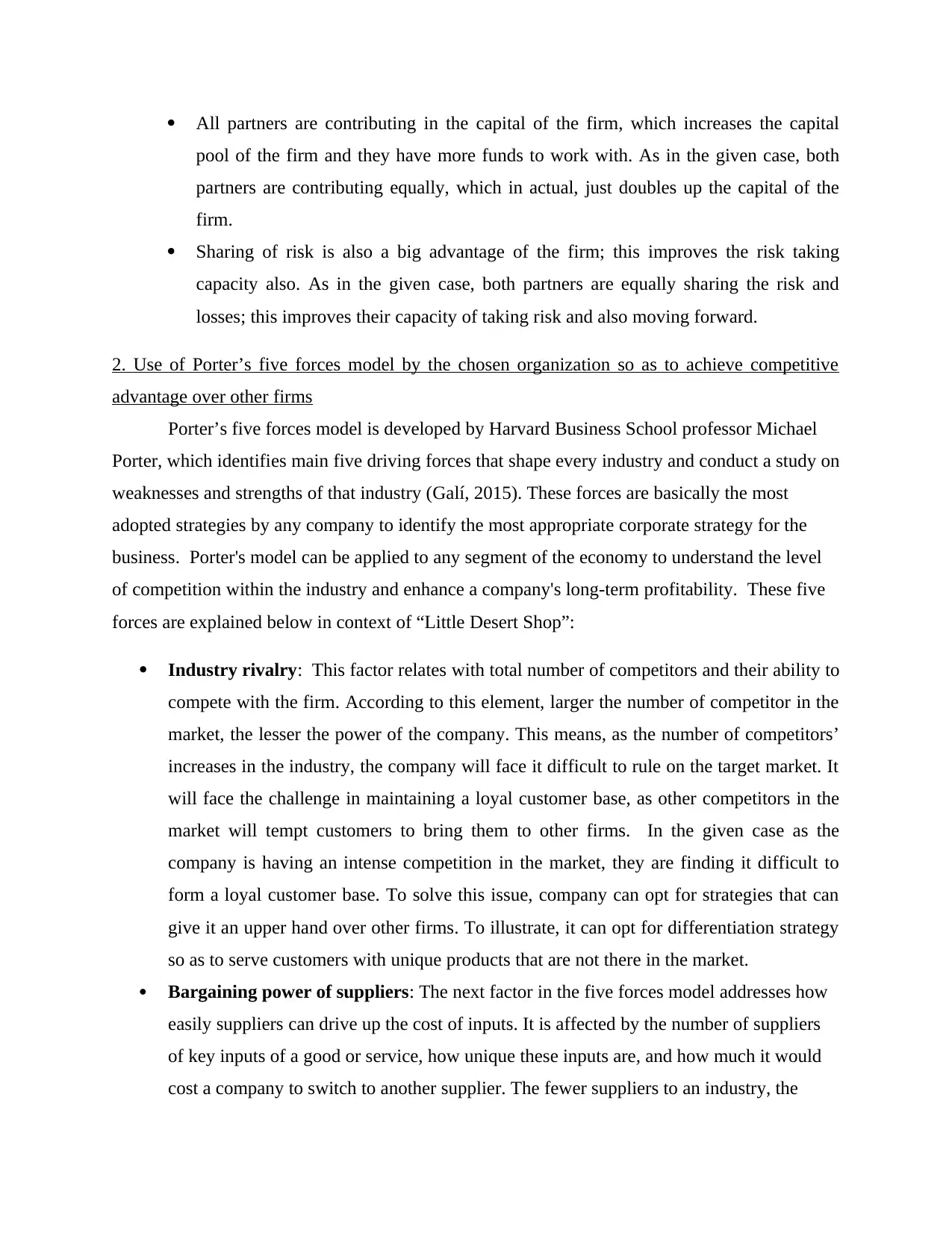
All partners are contributing in the capital of the firm, which increases the capital
pool of the firm and they have more funds to work with. As in the given case, both
partners are contributing equally, which in actual, just doubles up the capital of the
firm.
Sharing of risk is also a big advantage of the firm; this improves the risk taking
capacity also. As in the given case, both partners are equally sharing the risk and
losses; this improves their capacity of taking risk and also moving forward.
2. Use of Porter’s five forces model by the chosen organization so as to achieve competitive
advantage over other firms
Porter’s five forces model is developed by Harvard Business School professor Michael
Porter, which identifies main five driving forces that shape every industry and conduct a study on
weaknesses and strengths of that industry (Galí, 2015). These forces are basically the most
adopted strategies by any company to identify the most appropriate corporate strategy for the
business. Porter's model can be applied to any segment of the economy to understand the level
of competition within the industry and enhance a company's long-term profitability. These five
forces are explained below in context of “Little Desert Shop”:
Industry rivalry: This factor relates with total number of competitors and their ability to
compete with the firm. According to this element, larger the number of competitor in the
market, the lesser the power of the company. This means, as the number of competitors’
increases in the industry, the company will face it difficult to rule on the target market. It
will face the challenge in maintaining a loyal customer base, as other competitors in the
market will tempt customers to bring them to other firms. In the given case as the
company is having an intense competition in the market, they are finding it difficult to
form a loyal customer base. To solve this issue, company can opt for strategies that can
give it an upper hand over other firms. To illustrate, it can opt for differentiation strategy
so as to serve customers with unique products that are not there in the market.
Bargaining power of suppliers: The next factor in the five forces model addresses how
easily suppliers can drive up the cost of inputs. It is affected by the number of suppliers
of key inputs of a good or service, how unique these inputs are, and how much it would
cost a company to switch to another supplier. The fewer suppliers to an industry, the
pool of the firm and they have more funds to work with. As in the given case, both
partners are contributing equally, which in actual, just doubles up the capital of the
firm.
Sharing of risk is also a big advantage of the firm; this improves the risk taking
capacity also. As in the given case, both partners are equally sharing the risk and
losses; this improves their capacity of taking risk and also moving forward.
2. Use of Porter’s five forces model by the chosen organization so as to achieve competitive
advantage over other firms
Porter’s five forces model is developed by Harvard Business School professor Michael
Porter, which identifies main five driving forces that shape every industry and conduct a study on
weaknesses and strengths of that industry (Galí, 2015). These forces are basically the most
adopted strategies by any company to identify the most appropriate corporate strategy for the
business. Porter's model can be applied to any segment of the economy to understand the level
of competition within the industry and enhance a company's long-term profitability. These five
forces are explained below in context of “Little Desert Shop”:
Industry rivalry: This factor relates with total number of competitors and their ability to
compete with the firm. According to this element, larger the number of competitor in the
market, the lesser the power of the company. This means, as the number of competitors’
increases in the industry, the company will face it difficult to rule on the target market. It
will face the challenge in maintaining a loyal customer base, as other competitors in the
market will tempt customers to bring them to other firms. In the given case as the
company is having an intense competition in the market, they are finding it difficult to
form a loyal customer base. To solve this issue, company can opt for strategies that can
give it an upper hand over other firms. To illustrate, it can opt for differentiation strategy
so as to serve customers with unique products that are not there in the market.
Bargaining power of suppliers: The next factor in the five forces model addresses how
easily suppliers can drive up the cost of inputs. It is affected by the number of suppliers
of key inputs of a good or service, how unique these inputs are, and how much it would
cost a company to switch to another supplier. The fewer suppliers to an industry, the
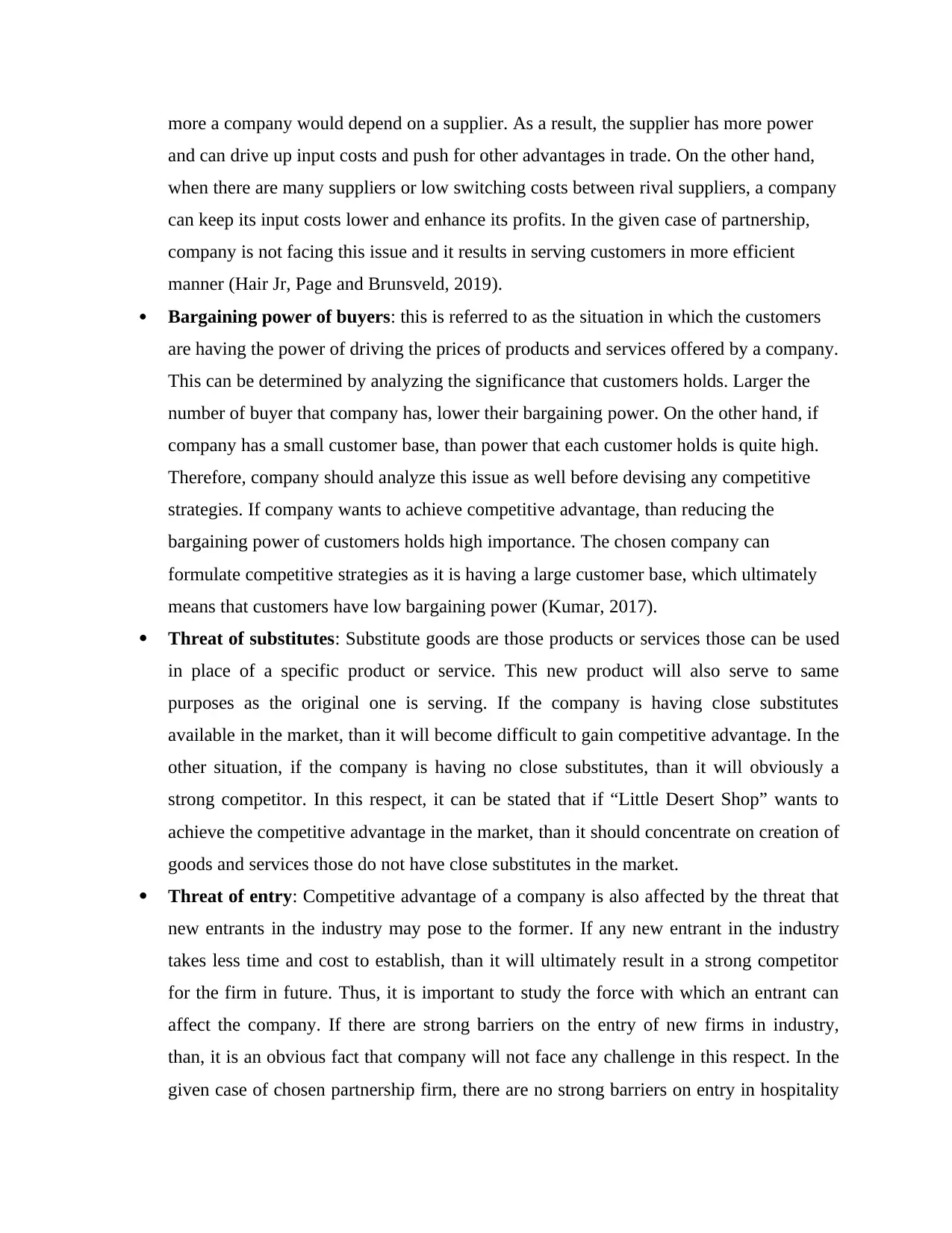
more a company would depend on a supplier. As a result, the supplier has more power
and can drive up input costs and push for other advantages in trade. On the other hand,
when there are many suppliers or low switching costs between rival suppliers, a company
can keep its input costs lower and enhance its profits. In the given case of partnership,
company is not facing this issue and it results in serving customers in more efficient
manner (Hair Jr, Page and Brunsveld, 2019).
Bargaining power of buyers: this is referred to as the situation in which the customers
are having the power of driving the prices of products and services offered by a company.
This can be determined by analyzing the significance that customers holds. Larger the
number of buyer that company has, lower their bargaining power. On the other hand, if
company has a small customer base, than power that each customer holds is quite high.
Therefore, company should analyze this issue as well before devising any competitive
strategies. If company wants to achieve competitive advantage, than reducing the
bargaining power of customers holds high importance. The chosen company can
formulate competitive strategies as it is having a large customer base, which ultimately
means that customers have low bargaining power (Kumar, 2017).
Threat of substitutes: Substitute goods are those products or services those can be used
in place of a specific product or service. This new product will also serve to same
purposes as the original one is serving. If the company is having close substitutes
available in the market, than it will become difficult to gain competitive advantage. In the
other situation, if the company is having no close substitutes, than it will obviously a
strong competitor. In this respect, it can be stated that if “Little Desert Shop” wants to
achieve the competitive advantage in the market, than it should concentrate on creation of
goods and services those do not have close substitutes in the market.
Threat of entry: Competitive advantage of a company is also affected by the threat that
new entrants in the industry may pose to the former. If any new entrant in the industry
takes less time and cost to establish, than it will ultimately result in a strong competitor
for the firm in future. Thus, it is important to study the force with which an entrant can
affect the company. If there are strong barriers on the entry of new firms in industry,
than, it is an obvious fact that company will not face any challenge in this respect. In the
given case of chosen partnership firm, there are no strong barriers on entry in hospitality
and can drive up input costs and push for other advantages in trade. On the other hand,
when there are many suppliers or low switching costs between rival suppliers, a company
can keep its input costs lower and enhance its profits. In the given case of partnership,
company is not facing this issue and it results in serving customers in more efficient
manner (Hair Jr, Page and Brunsveld, 2019).
Bargaining power of buyers: this is referred to as the situation in which the customers
are having the power of driving the prices of products and services offered by a company.
This can be determined by analyzing the significance that customers holds. Larger the
number of buyer that company has, lower their bargaining power. On the other hand, if
company has a small customer base, than power that each customer holds is quite high.
Therefore, company should analyze this issue as well before devising any competitive
strategies. If company wants to achieve competitive advantage, than reducing the
bargaining power of customers holds high importance. The chosen company can
formulate competitive strategies as it is having a large customer base, which ultimately
means that customers have low bargaining power (Kumar, 2017).
Threat of substitutes: Substitute goods are those products or services those can be used
in place of a specific product or service. This new product will also serve to same
purposes as the original one is serving. If the company is having close substitutes
available in the market, than it will become difficult to gain competitive advantage. In the
other situation, if the company is having no close substitutes, than it will obviously a
strong competitor. In this respect, it can be stated that if “Little Desert Shop” wants to
achieve the competitive advantage in the market, than it should concentrate on creation of
goods and services those do not have close substitutes in the market.
Threat of entry: Competitive advantage of a company is also affected by the threat that
new entrants in the industry may pose to the former. If any new entrant in the industry
takes less time and cost to establish, than it will ultimately result in a strong competitor
for the firm in future. Thus, it is important to study the force with which an entrant can
affect the company. If there are strong barriers on the entry of new firms in industry,
than, it is an obvious fact that company will not face any challenge in this respect. In the
given case of chosen partnership firm, there are no strong barriers on entry in hospitality
⊘ This is a preview!⊘
Do you want full access?
Subscribe today to unlock all pages.

Trusted by 1+ million students worldwide
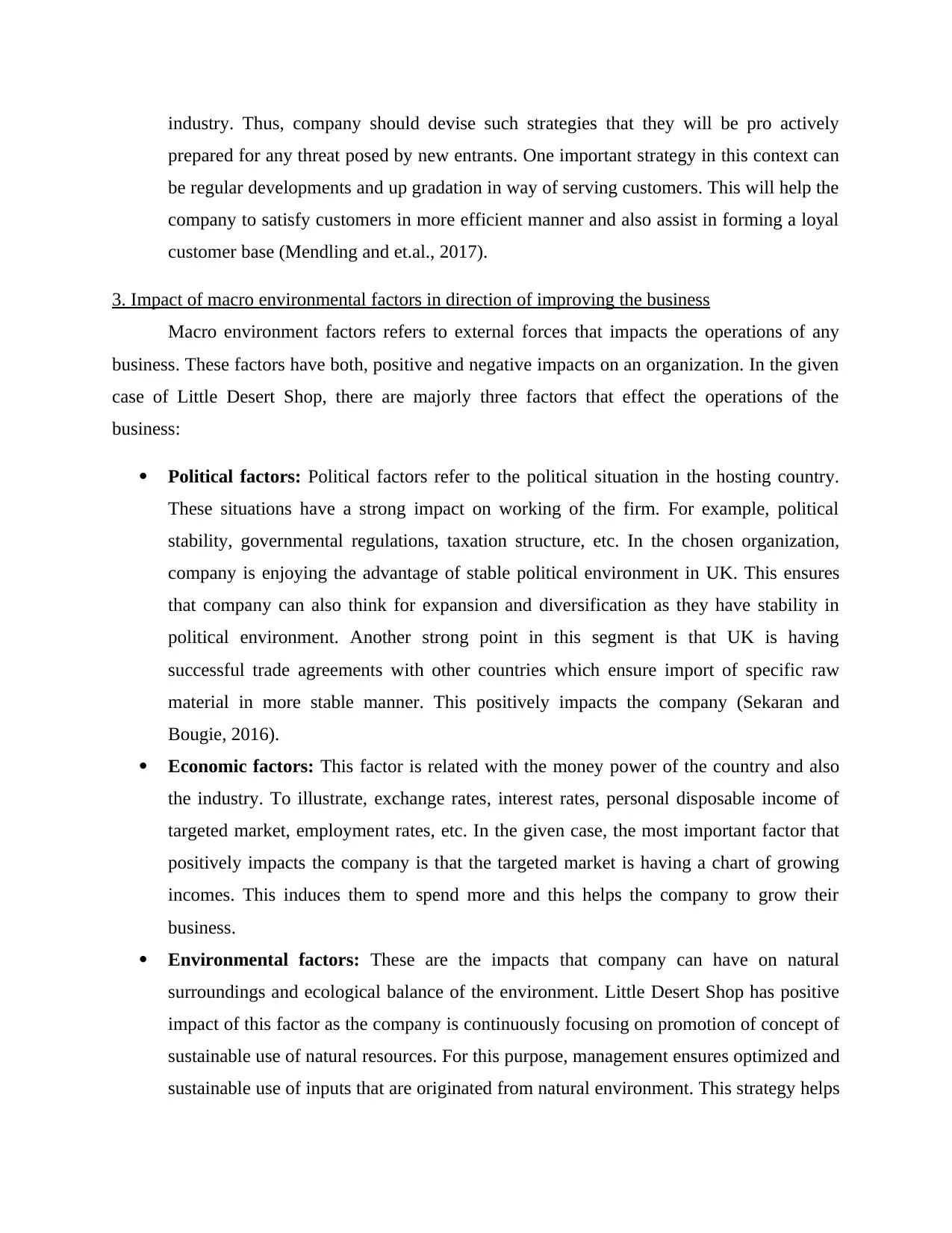
industry. Thus, company should devise such strategies that they will be pro actively
prepared for any threat posed by new entrants. One important strategy in this context can
be regular developments and up gradation in way of serving customers. This will help the
company to satisfy customers in more efficient manner and also assist in forming a loyal
customer base (Mendling and et.al., 2017).
3. Impact of macro environmental factors in direction of improving the business
Macro environment factors refers to external forces that impacts the operations of any
business. These factors have both, positive and negative impacts on an organization. In the given
case of Little Desert Shop, there are majorly three factors that effect the operations of the
business:
Political factors: Political factors refer to the political situation in the hosting country.
These situations have a strong impact on working of the firm. For example, political
stability, governmental regulations, taxation structure, etc. In the chosen organization,
company is enjoying the advantage of stable political environment in UK. This ensures
that company can also think for expansion and diversification as they have stability in
political environment. Another strong point in this segment is that UK is having
successful trade agreements with other countries which ensure import of specific raw
material in more stable manner. This positively impacts the company (Sekaran and
Bougie, 2016).
Economic factors: This factor is related with the money power of the country and also
the industry. To illustrate, exchange rates, interest rates, personal disposable income of
targeted market, employment rates, etc. In the given case, the most important factor that
positively impacts the company is that the targeted market is having a chart of growing
incomes. This induces them to spend more and this helps the company to grow their
business.
Environmental factors: These are the impacts that company can have on natural
surroundings and ecological balance of the environment. Little Desert Shop has positive
impact of this factor as the company is continuously focusing on promotion of concept of
sustainable use of natural resources. For this purpose, management ensures optimized and
sustainable use of inputs that are originated from natural environment. This strategy helps
prepared for any threat posed by new entrants. One important strategy in this context can
be regular developments and up gradation in way of serving customers. This will help the
company to satisfy customers in more efficient manner and also assist in forming a loyal
customer base (Mendling and et.al., 2017).
3. Impact of macro environmental factors in direction of improving the business
Macro environment factors refers to external forces that impacts the operations of any
business. These factors have both, positive and negative impacts on an organization. In the given
case of Little Desert Shop, there are majorly three factors that effect the operations of the
business:
Political factors: Political factors refer to the political situation in the hosting country.
These situations have a strong impact on working of the firm. For example, political
stability, governmental regulations, taxation structure, etc. In the chosen organization,
company is enjoying the advantage of stable political environment in UK. This ensures
that company can also think for expansion and diversification as they have stability in
political environment. Another strong point in this segment is that UK is having
successful trade agreements with other countries which ensure import of specific raw
material in more stable manner. This positively impacts the company (Sekaran and
Bougie, 2016).
Economic factors: This factor is related with the money power of the country and also
the industry. To illustrate, exchange rates, interest rates, personal disposable income of
targeted market, employment rates, etc. In the given case, the most important factor that
positively impacts the company is that the targeted market is having a chart of growing
incomes. This induces them to spend more and this helps the company to grow their
business.
Environmental factors: These are the impacts that company can have on natural
surroundings and ecological balance of the environment. Little Desert Shop has positive
impact of this factor as the company is continuously focusing on promotion of concept of
sustainable use of natural resources. For this purpose, management ensures optimized and
sustainable use of inputs that are originated from natural environment. This strategy helps
Paraphrase This Document
Need a fresh take? Get an instant paraphrase of this document with our AI Paraphraser
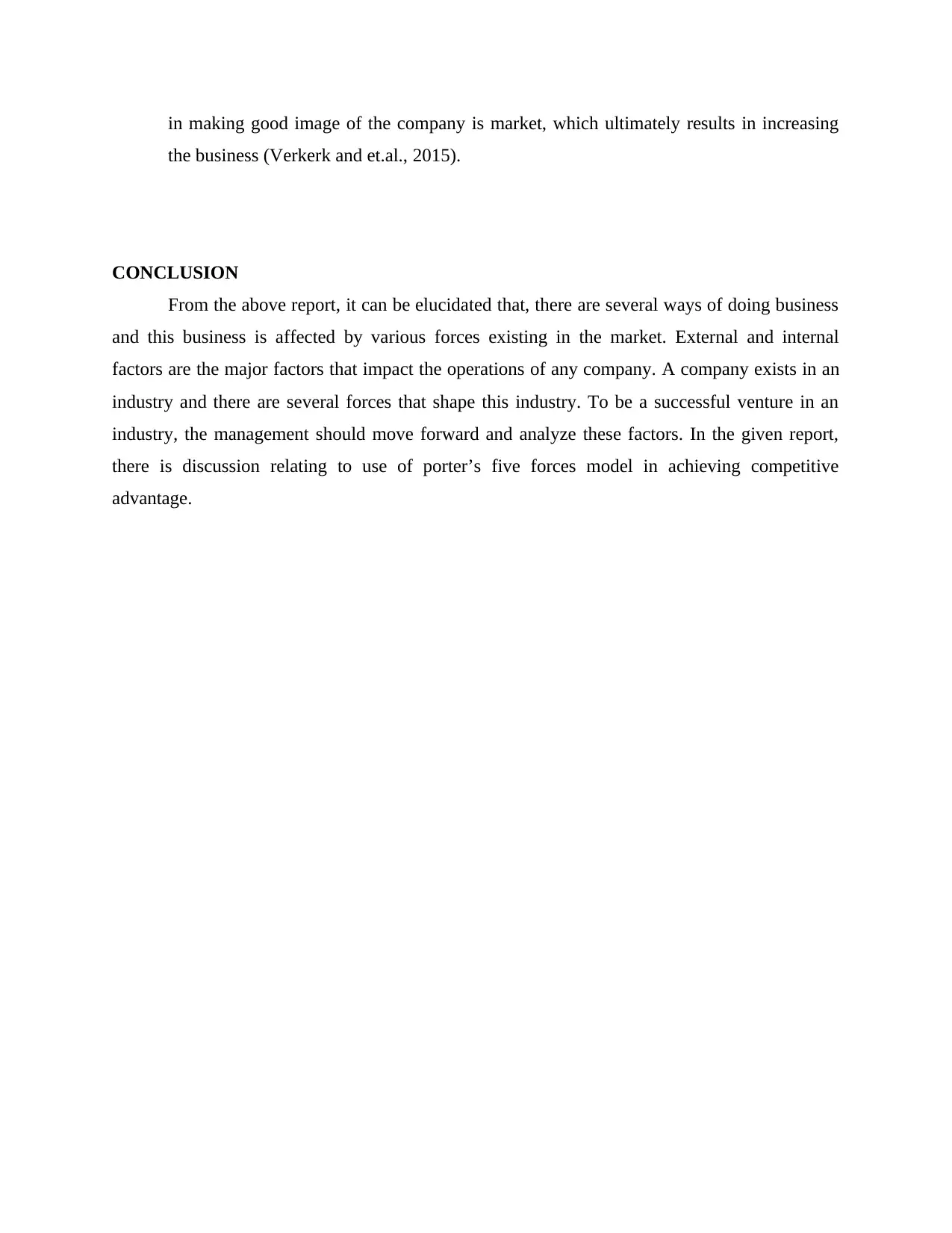
in making good image of the company is market, which ultimately results in increasing
the business (Verkerk and et.al., 2015).
CONCLUSION
From the above report, it can be elucidated that, there are several ways of doing business
and this business is affected by various forces existing in the market. External and internal
factors are the major factors that impact the operations of any company. A company exists in an
industry and there are several forces that shape this industry. To be a successful venture in an
industry, the management should move forward and analyze these factors. In the given report,
there is discussion relating to use of porter’s five forces model in achieving competitive
advantage.
the business (Verkerk and et.al., 2015).
CONCLUSION
From the above report, it can be elucidated that, there are several ways of doing business
and this business is affected by various forces existing in the market. External and internal
factors are the major factors that impact the operations of any company. A company exists in an
industry and there are several forces that shape this industry. To be a successful venture in an
industry, the management should move forward and analyze these factors. In the given report,
there is discussion relating to use of porter’s five forces model in achieving competitive
advantage.
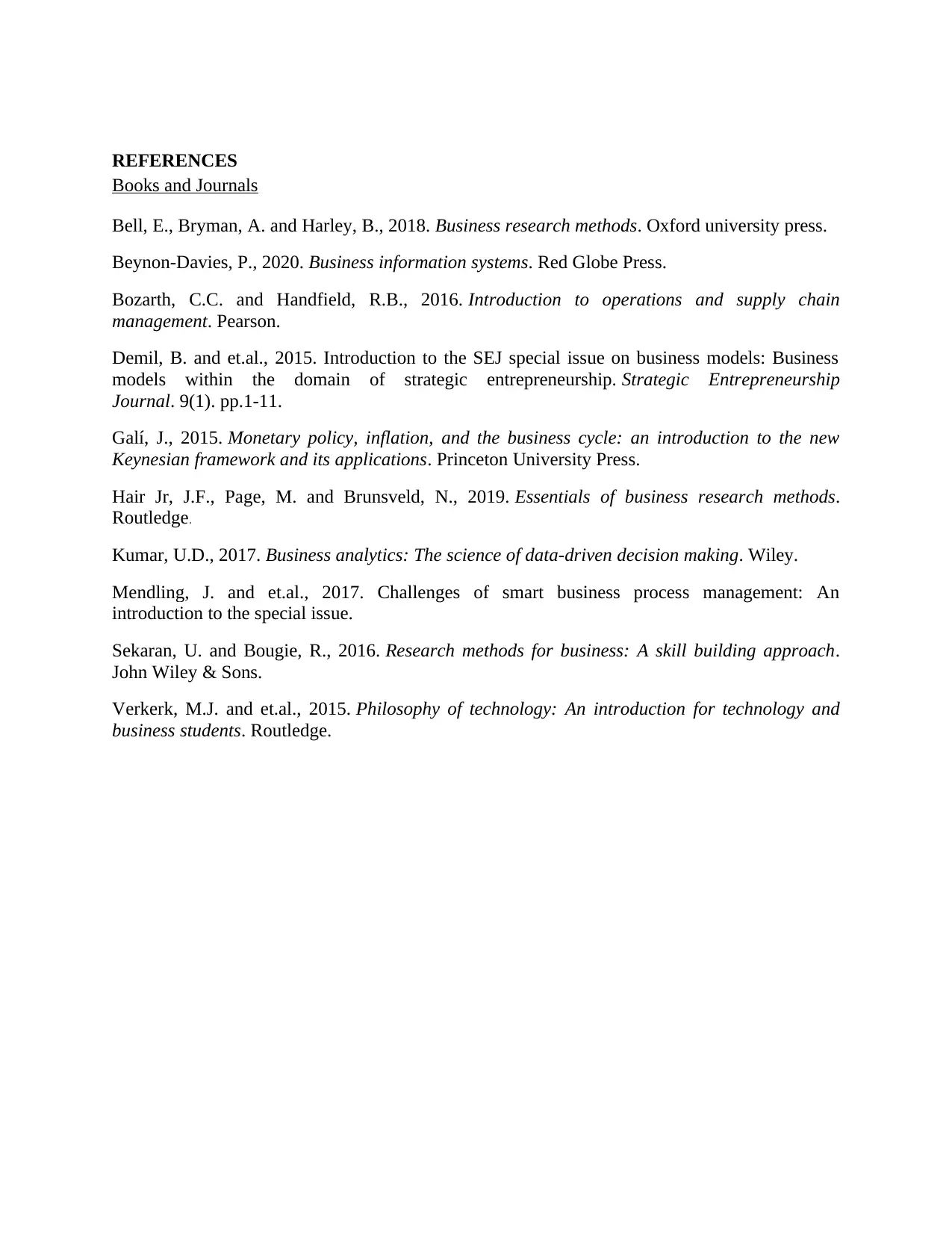
REFERENCES
Books and Journals
Bell, E., Bryman, A. and Harley, B., 2018. Business research methods. Oxford university press.
Beynon-Davies, P., 2020. Business information systems. Red Globe Press.
Bozarth, C.C. and Handfield, R.B., 2016. Introduction to operations and supply chain
management. Pearson.
Demil, B. and et.al., 2015. Introduction to the SEJ special issue on business models: Business
models within the domain of strategic entrepreneurship. Strategic Entrepreneurship
Journal. 9(1). pp.1-11.
Galí, J., 2015. Monetary policy, inflation, and the business cycle: an introduction to the new
Keynesian framework and its applications. Princeton University Press.
Hair Jr, J.F., Page, M. and Brunsveld, N., 2019. Essentials of business research methods.
Routledge.
Kumar, U.D., 2017. Business analytics: The science of data-driven decision making. Wiley.
Mendling, J. and et.al., 2017. Challenges of smart business process management: An
introduction to the special issue.
Sekaran, U. and Bougie, R., 2016. Research methods for business: A skill building approach.
John Wiley & Sons.
Verkerk, M.J. and et.al., 2015. Philosophy of technology: An introduction for technology and
business students. Routledge.
Books and Journals
Bell, E., Bryman, A. and Harley, B., 2018. Business research methods. Oxford university press.
Beynon-Davies, P., 2020. Business information systems. Red Globe Press.
Bozarth, C.C. and Handfield, R.B., 2016. Introduction to operations and supply chain
management. Pearson.
Demil, B. and et.al., 2015. Introduction to the SEJ special issue on business models: Business
models within the domain of strategic entrepreneurship. Strategic Entrepreneurship
Journal. 9(1). pp.1-11.
Galí, J., 2015. Monetary policy, inflation, and the business cycle: an introduction to the new
Keynesian framework and its applications. Princeton University Press.
Hair Jr, J.F., Page, M. and Brunsveld, N., 2019. Essentials of business research methods.
Routledge.
Kumar, U.D., 2017. Business analytics: The science of data-driven decision making. Wiley.
Mendling, J. and et.al., 2017. Challenges of smart business process management: An
introduction to the special issue.
Sekaran, U. and Bougie, R., 2016. Research methods for business: A skill building approach.
John Wiley & Sons.
Verkerk, M.J. and et.al., 2015. Philosophy of technology: An introduction for technology and
business students. Routledge.
⊘ This is a preview!⊘
Do you want full access?
Subscribe today to unlock all pages.

Trusted by 1+ million students worldwide
1 out of 9
Related Documents
Your All-in-One AI-Powered Toolkit for Academic Success.
+13062052269
info@desklib.com
Available 24*7 on WhatsApp / Email
![[object Object]](/_next/static/media/star-bottom.7253800d.svg)
Unlock your academic potential
Copyright © 2020–2025 A2Z Services. All Rights Reserved. Developed and managed by ZUCOL.





